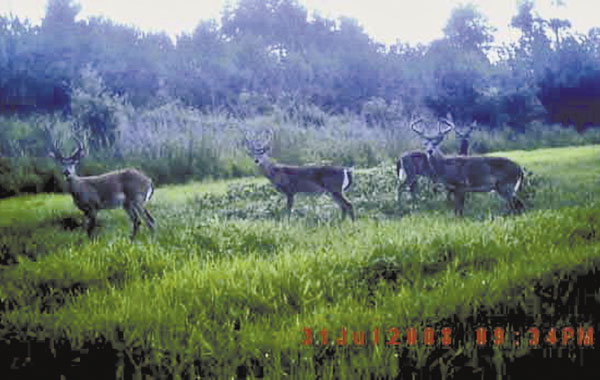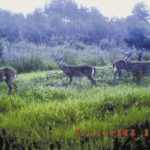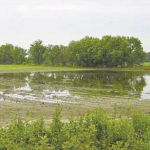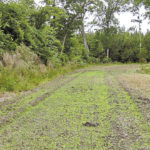
Preseason scouting is essential when determining the quality and abundance of deer on your land. Since May, bucks have been growing their headgear, brewing individualism in the herd. By August, antler development has peaked, and the hardening process has begun, but sweltering conditions can deter even the most eager outdoorsmen from logging hours in the woods scouting the upcoming crop of bucks.
Luckily, modern technology has allowed hunters to scout in several places at once, 24 hours a day, seven days a week, catching every moving entity with a heartbeat on film. Trail cameras have revolutionized deer hunting, providing hunters with photographic evidence of their deer herd. If set up in the right places, trail cameras can give hunters a picture of resident deer that will show up on the radar as the season approaches.
Late summer is a time when deer are at ease. With the help of booming agriculture and thriving, warm-season food plots, food is plentiful and few unnatural disturbances occur within their territories. Deer fall into a routine and are easily patterned. Bucks are in bachelor groups just before the hormones start flowing, which drives them apart. These groups will be concentrated around rich food sources with little disturbances.
Bachelor groups are most-often spotted during the late summer and just before the breeding season begins in late September. However, bucks start traveling in groups just after the breeding season ends earlier in the year. The breeding season is generally the only time when bucks split off from each other and travel solitary or in smaller groups, hunting down available mates.
Typically, bucks will travel with other bucks of similar age, but individual animals will move between different bachelor groups with animals of different age classes. Deer are social animals with a social hierarchy; it takes all year for an individual deer to understand its place in the herd. Subordinate, 1½- to 2½-year-old bucks are often noticed traveling in a group of older mature bucks.
By August, antler development has peaked, and the hardening process has begun. The structure and antler characteristics visible should be recognizable during the upcoming deer season. Photo-documentation of these bucks allows hunters and wildlife managers to identify individual deer as they develop their harvest goals and schedule.
Deer will be form a daily routine centered around rich foods, fresh water and nearby cover. They are suckers for agriculture crops in the late summer, when fields flourish with supple, nutrient-rich foliage and tender peanuts and soybeans. These areas are prime places to set up trail cameras to monitor main trails entering and exiting these fields, hopefully catching these bachelor groups in action.
Most warm-season food plots have played out from over-browsing, inconsistent rainfall or weed invasion. However, lingering summer food plots in remote areas are also good places to set up when local agriculture is lacking wildlife-favorable crops.
Even during the summer when unnatural pressures are low, bachelor groups prefer food sources in protected areas away from highways. Sometimes, the best groups of bachelors show up on film feasting on a few bags of corn placed deep in the woods.
Two main factors should be considered for trail-camera placement: trigger point and peripheral coverage. Often, cameras may only get one shot at the bachelor group in passing. Bucks will be traveling together, but not be close enough to touch each other’s hooves. Even though bucks will not be physically fighting, they will continue to show acts of dominance and submission.
Most cameras will take a photo and then incur a delay from 30 seconds to 30 minutes. Most cameras today have extensive memory capabilities, and the shortest delay period should be set to get the most shots. Some cameras even have a burst or continuous mode to take several shots consecutively. Cameras must be set up to take shots and get the maximum peripheral coverage.
When using corn, place the corn in a fairly wide-open place within the woods where several main trails converging. Place the corn near the camera in the center of the open area to catch deer in the trigger area and the outer fringe. Agriculture fields can be a problem, but generally, deer will frequent the same places within the field or will at least enter in the same place on each occasion. Moving cameras around from place to place can also be good ways to capture shots of bachelor groups. Don’t be afraid to set up two cameras on the same food plot, field or cornpile to capture different angles — and hopefully, the entire group of bachelor bucks frequenting the food source. One last note — exercise scent control when checking and setting cameras. This means rubber boots and close attention to scent dispersion throughout the collection area.
August is the last month to effectively-capture groups of bucks together during daylight hours. Get those cameras out and see what is out there. Deer season is just around the corner. Find out what’s in store for you and your hunting partners.
Control plot edges from ‘space invaders‘
Even though summer is still sizzling, the fall food-plot planting season grows near. Summer months offer opportunities to manipulate habitat and to create new food plots, but existing plots may need some attention as well to clean up the edges and retain the maximum acreage intended to grow rich foods for wildlife.
When a tree falls in the forest, a gap is created — just like when food plots are cleared. Shrubs, vines and saplings like nothing better than to invade empty spaces. While animals compete for food, water and space, plants also compete similarly for these metabolic requirements. In fact, plants require sunlight to photosynthesize and produce energy. Adjacent plants and dormant seeds are ready to invade these areas to gain further access to the sun’s rays. After several months of growing, land managers must crank up the tractor and control the margins of food plots — chemically or physically. Food plots will get choked from adjacent invaders quickly in the summer growing season. Mowing strips along the margins or using side-cut mowers are helpful. Physical removal is helpful to remove unwanted vegetation along the edges of food plots.
Mowing is beneficial in so many ways. In addition to restoring existing food plots, the vegetation control on adjacent woods allows sunlight to penetrate to the food-plot margins, maximizing the effectiveness of the food plot itself.
Deer are an edge species, and periodic mowing of edges encourages sprouting of tender grasses, forbs, shrubs and young saplings. In addition to deer, wildlife such as quail and rabbit will benefit. The low cover that sprouts back will provide escape cover and serve as a food source. Mowing adjacent to cover is always beneficial and should be part of routine operations throughout an area specifically managed for wildlife.
Install surface drains on wet plots
Food-plot aficionados should be preparing food plots for the fall planting season, which begins in September. Food-plot placement often tends to be focused around previously cleared areas or newly cleared areas adjacent to existing deer stands. Often, the soil conditions and drainage on these sites is not always optimum. However, soil properties can be tweaked with treatments of limestone or highly-fertile animal products.
Wetter sites or areas lower on the landscape produce some of the most lush plots favored by wildlife, but they quickly incur problems when periods of wet weather become frequent. Just about any seed planted in a food-plot can be drowned. While some water problems cannot be prevented on some sites, water ponding can usually be eliminated through shallow drainage ditches. Plantings from previous years generally will reveal areas with drainage problems.
Ditches do not have to be deep to effectively move surface water off a food plot. Usually, 12 inches is the key depth, but Sir Isaac Newton’s law of gravity will play the fundamental role in construction of these ditches. They must be connected to an outfall or a lower drainage feature to carry excess water downhill and away from the plot.
Shallow drainage ditches can be constructed using an angled blade on a tractor blade or small backhoe, or these ditches can even be constructed with a little elbow grease and a shovel.
As an alternative, a food plot can be graded before planting, installing adequate slopes to prevent ponding of water during excessive rainfall events.







Be the first to comment